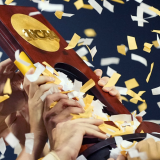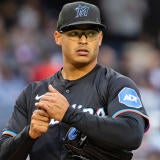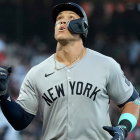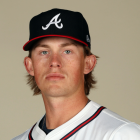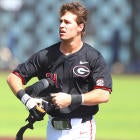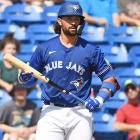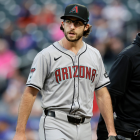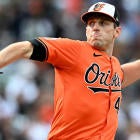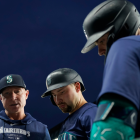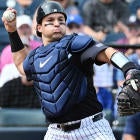Baseball's new season is nearly upon us, making this that time of the year when we draw names from a hat and call them breakout candidates. Okay, so our process is a little more involved than that, but a new season isn't a new season until we make our best guesses at which players are likely to perform better than expected.
As such, we've identified one player from every team who we think is in for a better year than anticipated. We tried, for the most part, to avoid the obvious candidates -- the Byron Buxtons of the world who used to be No. 1 prospects and just haven't put things together yet. That doesn't mean we abstained from post-hype sleepers entirely -- and to be sure we have some players who stretch the premise -- but whatever. It's meant to be a fun exercise, not an exact science.
With those legally obligated caveats in place, let's get to the fireworks factory.
| Ketel Marte: It may seem weird to nominate Marte after an impressive 2018 (he recorded a 100 OPS+ and set a new career-high with 3.3 wins above replacement), but we think he possesses even greater upside. Marte has improved his strikeout rate in consecutive seasons, and last year he showed more power than he had in the past by notching 26 triples-plus-home runs -- or 11 more than he had tallied in his first 249 games. The one concern we have here is with his defensive home, as the Diamondbacks have talked about playing him all over following their recent signing of Adam Jones. Provided Marte takes well to a super-utility role, he could cement himself as one of the sport's most underrated players. | |
| Kevin Gausman: Although Kevin Gausman has dealt with shoulder issues this spring, he appears likely to open the season in the big-league rotation. We're looking forward to seeing if this is the year where he's able to keep his home-run rate in check: He's allowed at least 1.3 dingers per nine in each of his last four tries. Gausman altered his pitch selection following July's trade, using his splitter more frequently (from 24.3 percent to 32.6 percent) in place of his slider (from 16 percent to 10.4 percent). Gausman's homer-per-fly ball rate dropped significantly, and his swinging strike rate improved marginally -- even if his strikeout rate went down by nearly one per nine. If Gausman can continue to miss barrels, he has a chance to be an above-average starter more often than at any point in the past. | |
| Tanner Scott: Look past Tanner Scott's unsightly 5.40 ERA and there's a lot to like. Scott throws hard and imparts high spin rates on both his heater and his slider, a pitch that generated whiffs on more than 55 percent of the swings taken against it in 2018. The Orioles are now managed by former Astros employees, and it stands to reason they could have him throw the pitch more than half the time. If so, Scott could find himself following the Brad Hand route to a high-leverage role. | |
| Tyler Thornburg: The thing about winning the World Series is that it tends to mean a bunch of your players had good seasons. That's why we're left picking Tyler Thornburg, an immediately risky choice. Thornburg didn't pitch well last season and hasn't posted good numbers this spring. His fastball and curveball continue to possess high spin rates, however, and there's a chance he rounds into shape as a respectable middle reliever -- albeit not the high-grade one Boston wanted when it traded Travis Shaw(among others) for his services back in December 2016. | |
| Daniel Descalso: Technically Daniel Descalso was the biggest free-agent addition the Cubs made over the winter. We're choosing him anyway because no one outside of the front office seems to have noticed he's turned into a quality platoon piece. Descalso has posted at least a .760 OPS against right-handed pitchers in each of the past three seasons. He improved his launch angle and exit velocity last year, making him a greater threat to jump the yard. Add in how Descalso can play multiple defensive positions and how he's used to coming off the bench, and we think he'll contribute more to the Cubs than his past suggests. | |
| Jace Fry: Jace Fry is now 70 appearances into his big-league career. Over those, he's compiled a 5.12 ERA and has checked in below replacement-level, per Baseball-Reference. Whatever. Fry has a high-grade cutter/slider thingamajig that coerced whiffs nearly half the time it was offered at. He struck out about a third of the batters he faced last season, and was effective against lefties and righties alike. Maybe we're missing something and he'll continue to run a far, far higher ERA than his stuff and underlying statistics suggest, but we think he's in for a big year. | |
| Matt Wisler: Another team, another reliever. Matt Wisler joined the Reds in July and made 11 appearances. It's a small sample, of course, but he upped his slider usage to the point where he was throwing more bendy pitches than fastballs. That seems like a wise decision, given the whiff rate on his slider (40 percent) versus his fastballs (both under six percent). We'll see if Wisler stands by his tweak in the new year (he was reassigned at the end of spring training and will need to pass through waivers). He should, though, as it may be his best shot at a meaningful career. | |
| Jordan Luplow: We find Jordan Luplow interesting for some basic and speculative reasons. Foremost, he commands the strike zone. Next, he seems like the perfect candidate for Cleveland's player development staff to work its magic. Luplow has seemingly switched from a toe tap to a leg kick since last season, a change that could help him tap into his raw power. If Luplow can make harder contact, he could turn into more than Brandon Guyer's replacement. | |
| Jon Gray: A layup. Jon Gray has big-time stuff and underlying measures suggested he was much better than his bloated 5.12 ERA indicated. Were we in charge of a team, we would be calling left and right to land Gray in a trade -- if only to go ghost-hunting with him during the winter. | |
| Joe Jimenez: Another layup, in our opinion. Everyone knows Joe Jimenez throws hard -- his fastball averaged more than 95 mph in 2018. What most don't realize is that he threw more strikes than the average pitcher and missed significantly more bats last season. Jimenez had a rough second half, permitting 17 runs in 19 innings, but we think he'll end the year as Detroit's closer. | |
| Chris Devenski: Entering last season, Chris Devenski was the majors' new "it reliever." In his first two seasons, he'd posted a 168 ERA+ and more than four strikeouts per walk. Last year didn't go as well for Devenski, who permitted 60 percent as many home runs in 47 innings (nine) as he had in his first 188 (15). Blame it on injuries or variation, but we think Devenski will enjoy a more fruitful 2019 behind his strong fastball-changeup combination. | |
| Jorge Lopez: Last season the Royals unearthed a diamond in the rough in the form of Rule 5 pick Brad Keller, a right-hander with groundball tendencies. Jorge Lopez, acquired in the Mike Moustakas trade, may want to try to emulate Keller with his low-spin fastball and a curveball that hitters pounded into the dirt to the tune of an average launch angle of four degrees. Lopez has had a rough go of it in recent years, posting an ERA above 5.00 in two of his last three minor-league seasons. Still, we're curious to see if the Royals can help him find big-league success the way they did with Keller. | |
| Matt Harvey: When the Mets traded Matt Harvey last year, we were skeptical of his chances of becoming a solid big-league starter once more. It appears that Harvey did just that, however, in part by improving his slider. Harvey upped his spin rate to new Statcast-era personal-highs. Obviously pitching isn't that simple: he still struggled with home runs, and his past injury woes are concerning. But the Angels have ample reason to think he could be a mid-rotation starter. | |
| Yimi Garcia: Once upon a time, Yimi Garcia looked like a workhorse middle reliever. He's since thrown just 30 big-league innings over the last three seasons due to injury. Garcia's ugly 5.64 ERA last season aside, he demonstrated that his high-spin fastball and high-grade control remains in place. Alas, so too does Garcia's proneness to the long ball. He'll be at the whims of the gods, but we think he's due for a good season. | |
| Trevor Richards: Formerly an indy-ball find, Trevor Richards has a cool story and a great changeup -- one that batters whiffed on more than 40 percent of the time. He's thrown a lot of strikes throughout his professional career. We're betting on him cutting into his walk rate this season, and cementing that signing him is one of the Marlins' better moves in recent memory. | |
| Orlando Arcia: Orlando Arcia is an aesthetically pleasing defender, of that there's no doubt. Of his bat, there's much doubt. Scouts used to regard him as a potential No. 2 hitter thanks to his on-base skills. Those, unfortunately, have not translated to the majors. In parts of three seasons he's yet to demonstrate he can make quality contact on a consistent basis, and last year he posted career-worst walk and strikeout rates. Oy. We'll hold out hope that he'll figure it out this season, but it wouldn't shock us if he loses his starting gig well before the postseason begins. | |
| Max Kepler: Max Kepler has posted a 96 OPS+ three seasons running. Yet look deeper and you'll find signs of progress. Kepler shaved his strikeout rate and upped his walk rate last season by making contact more often and expanding his zone less often. He also improved his launch angle and his exit velocity. All of that together should have resulted in better surface numbers. Maybe Kepler is perpetually doomed to post a 96 OPS+, but we'll take the over based on those positive indicators. | |
| Robert Gsellman: We're not saying Robert Gsellman is going to turn into Mariano Rivera (or even Edwin Diaz), but we think he'll fare better in his second full season as a reliever. How could he not? He throws hard and has a high-spin curveball. Last year, he struck out 7.9 batters per nine and held the opposition to fewer than nine hits and one home run per nine. Of the 91 pitchers to do that over 50-plus innings, Gsellman finished with the second-to-worst ERA+; 83 of them, meanwhile, had an ERA+ better than 100. We're guessing Gsellman ends up above that mark in 2019. | |
| DJ LeMahieu: We'll keep this one simple: DJ LeMahieu has always hit, and there's no reason to think he'll stop now. At minimum, ball-tracking data suggests he hit the ball harder last season than typical -- and at a higher launch angle. Generally, that's a good sign. LeMahieu doesn't strike out often, and has the kind of bat-to-ball skills that managers used to dream about from their two-hole hitters. We don't know what his role will look like just yet with the Yankees, but we think he'll prove that he's more than a Coors Field creation. | |
| Marco Estrada: We've made the case for Marco Estrada as a bounce-back candidate a few times. It goes like this: He still throws strikes and misses bats with a vertical-based approach. That, plus the spacious ballpark afforded to him in Oakland and the general year-to-year volatility of home-run rates, makes us think he's likely to be better than he was last season. The A's sure will need him to be if they're going to make another postseason run. | |
| Nick Pivetta: Nick Pivetta is a popular breakout pick for fair reasons. He struck out nearly four times as many batters he walked; he made strides with his curveball; and his fastball clocks in around 95 mph. Sequencing seems to be the main reason he hasn't ascended to a higher level. For example, last season Pivetta posted a 4.77 ERA despite a 3.80 FIP and 3.40 DRA. Maybe every advanced metric and line of reasoning is missing something, but we're going to roll with the masses and say it's more likely Pivetta has his breakout year in 2019. | |
| Jordan Lyles: In a sense, Jordan Lyles enjoyed his breakout effort last year. He altered his delivery, allowing him to throw more strikes, and took to using his outpitch curveball more often. The results were encouraging and convinced the Pirates to give him a chance at making their rotation. Even if Lyles ends up in the bullpen, we think he can show last season was the start of a new normal rather than an outlier effort in an otherwise mediocre career. | |
| Matt Strahm: The Padres are a dark horse pick to win a Wild Card spot in the National League. If they're to do so, they'll need Matt Strahm to take well to the rotation. Strahm has shown he's at minimum a high-quality reliever behind his high-spin fastball and swing-and-miss slider (he generated a whiff rate nearing 60 percent last season). If he can stay healthy and throw strikes -- and who knows on either front -- he could give San Diego's weakest unit a big-time boost. | |
| Drew Pomeranz: Injuries will dictate whether or not Drew Pomeranz is this year's Derek Holland -- that is a down-on-their-luck lefty who finds new life with the Giants. Before 2018, Pomeranz had proven himself to be a capable big-league arm who had enjoyed success as a starter and reliever behind his signature breaking ball. He didn't cover himself in glory last season, as he struggled to find the plate and to avoid barrels, but we're willing to overlook that for now. | |
| Domingo Santana: Domingo Santana led the 2017 Brewers in OPS+. That's a forgotten accomplishment now, after a season in which Santana was displaced by Christian Yelich and Lorenzo Cain and struggled when he did play. There's certainly risk with Santana -- he's prone to swinging and missing and he's a poor defender -- but he walks and hits the ball hard. That's most of hitting. We buy a rebound season from one of Seattle's savviest offseason additions. | |
| Dominic Leone: By no means did Dominic Leone repeat his 2017, when he was a rubber-armed middle reliever who struck out more than 10 batters per nine innings. But we blame some of that on injuries. When Leone was hearty and hale, he still notched more than three strikeouts per walk. That counts for something. So does Leone's better-than-average ability to coerce whiffs and chases outside the zone. We'll give him another chance to show he's more than just another arm. | |
| Kevin Kiermaier: The Rays had a ton of players achieve more than anticipated last season. We're going with Kevin Kiermaier here because we think people are forgetting he's shown himself to be a good hitter in the past. Provided Kiermaier can stay healthy -- and it's no given -- we fully expect him to post an OPS+ closer to his 105 mark from 2015-17 than the 80 number he put up last year. | |
| Jeffrey Springs: It'd be reasonable to see Jeffrey Springs's name and ask, who? A former 30th-round pick, Springs debuted last July and went on to twirl 32 solid innings. He's a fastball-changeup lefty with a deceptive, crossfire delivery and the chance to gobble up innings in Texas's bullpen. One interesting note: Springs's plus change checks in 12 miles per hour slower than his fastball -- not quite Alex Claudio territory, but close. The Rangers would probably enjoy it if Springs can have Claudio-like success. | |
| Brandon Drury: Prior to last season, Brandon Drury seemed like a fine reserve and/or tolerable second-division starter. He struggled with injuries in 2018, finishing the campaign with a 42 OPS+ in 26 games split between the Yankees and Blue Jays. Woof. Drury upped his launch angle and seemed intent on improving his power production. We don't know if that'll happen, but we do think he's going to show why he used to be a sought-after player -- even if he's not long for the Blue Jays' third-base job. | |
| Kyle Barraclough: There's a fair chance Kyle Barraclough -- acquired in a small deal from the Marlins -- is non-tendered at season's end due to his ineffectiveness and at-times frustrating inefficiency. There's also a chance he returns to being a respectable late-inning reliever who makes up for his wildness with big-time strikeout numbers. | |








































